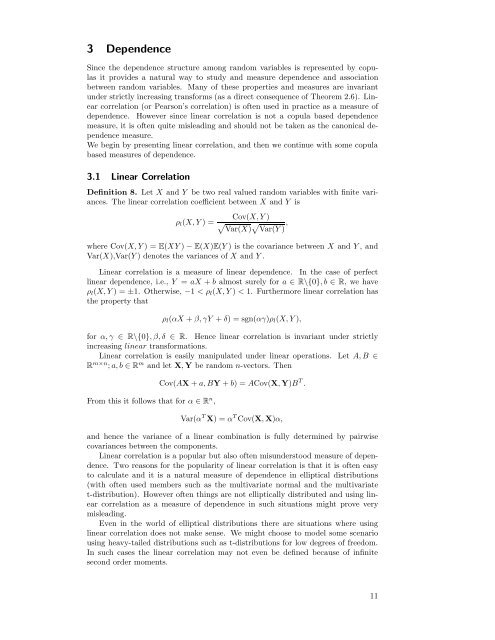Modelling Dependence with Copulas - IFOR
Modelling Dependence with Copulas - IFOR
Modelling Dependence with Copulas - IFOR
You also want an ePaper? Increase the reach of your titles
YUMPU automatically turns print PDFs into web optimized ePapers that Google loves.
3 <strong>Dependence</strong><br />
Since the dependence structure among random variables is represented by copulas<br />
it provides a natural way to study and measure dependence and association<br />
between random variables. Many of these properties and measures are invariant<br />
under strictly increasing transforms (as a direct consequence of Theorem 2.6). Linear<br />
correlation (or Pearson’s correlation) is often used in practice as a measure of<br />
dependence. However since linear correlation is not a copula based dependence<br />
measure, it is often quite misleading and should not be taken as the canonical dependence<br />
measure.<br />
We begin by presenting linear correlation, and then we continue <strong>with</strong> some copula<br />
based measures of dependence.<br />
3.1 Linear Correlation<br />
Definition 8. Let X and Y be two real valued random variables <strong>with</strong> finite variances.<br />
The linear correlation coefficient between X and Y is<br />
ρ l (X, Y )=<br />
Cov(X, Y )<br />
√<br />
Var(X)<br />
√<br />
Var(Y )<br />
,<br />
where Cov(X, Y )=E(XY ) − E(X)E(Y ) is the covariance between X and Y ,and<br />
Var(X),Var(Y ) denotes the variances of X and Y .<br />
Linear correlation is a measure of linear dependence. In the case of perfect<br />
linear dependence, i.e., Y = aX + b almost surely for a ∈ R\{0},b ∈ R, wehave<br />
ρ l (X, Y )=±1. Otherwise, −1
















